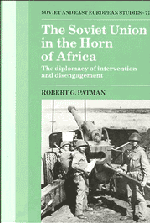Book contents
- Frontmatter
- Contents
- List of maps
- List of tables
- Preface
- List of abbreviations
- Note on transliteration of Russian words
- INTRODUCTION
- PART I MOTIVATIONAL ASPECTS
- PART II THE HORN OF OPPORTUNITY
- 4 The budding alliance: Marx, Lenin and Mohammed
- 5 The Ethiopian revolution and the quest for a Pax Sovietica
- 6 War, realignment and the enforcement of proletarian internationalism
- CONCLUSION
- Appendix A Soviet–Somali treaty of 11 July 1974
- Appendix B Soviet–Ethiopian treaty of 20 November 1978
- Notes
- Bibliography
- Index
- Soviet and East European Studies
6 - War, realignment and the enforcement of proletarian internationalism
Published online by Cambridge University Press: 29 January 2010
- Frontmatter
- Contents
- List of maps
- List of tables
- Preface
- List of abbreviations
- Note on transliteration of Russian words
- INTRODUCTION
- PART I MOTIVATIONAL ASPECTS
- PART II THE HORN OF OPPORTUNITY
- 4 The budding alliance: Marx, Lenin and Mohammed
- 5 The Ethiopian revolution and the quest for a Pax Sovietica
- 6 War, realignment and the enforcement of proletarian internationalism
- CONCLUSION
- Appendix A Soviet–Somali treaty of 11 July 1974
- Appendix B Soviet–Ethiopian treaty of 20 November 1978
- Notes
- Bibliography
- Index
- Soviet and East European Studies
Summary
When Somali troops invaded the territory of Ethiopia, the USSR sided with the victim of aggression, proceeding from the fundamental principles of its foreign policy, and at the request of Ethiopia is giving the country the appropriate material and technical assistance.
(Pravda, 22 January 1978)We will teach the Somalis a lesson they will never forget. They will be pushed back from the Ogaden and we will be back in Somalia – we will bring them to their knees.
(Georgiy Samsonov, Soviet Ambassador to Somalia, quoted in Newsweek, 13 February 1978, p. 14)In the space of just one year, Soviet policy in the Horn underwent a complete somersault. After the failure of the Marxist–Leninist confederation proposal in March 1977, Moscow made the critical decision that if a choice had to be made between Somalia and Ethiopia, it would opt for the latter. On 23 April 1977, the leader of the Dergue, Lt.-Col. Mengistu Haile Mariam, cleared the way for Moscow by expelling all US military advisers from Ethiopia and closing the Kagnew Communications Station and other US facilities in the country. Two weeks later, the new Soviet–Ethiopian alliance assumed a formal shape. On 6 May, during an official visit to the USSR, Mengistu signed a ‘Declaration on the Foundations of Friendly Relations and Co-operation’ between the USSR and Ethiopia. At the same time, the Soviet government concluded its second major arms package with Mengistu, reportedly worth $385 million. The agreement coincided with reports that a substantial number of Cuban military advisers had arrived in Addis Ababa.
- Type
- Chapter
- Information
- The Soviet Union in the Horn of AfricaThe Diplomacy of Intervention and Disengagement, pp. 204 - 254Publisher: Cambridge University PressPrint publication year: 1990



